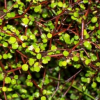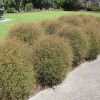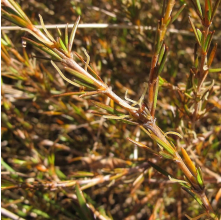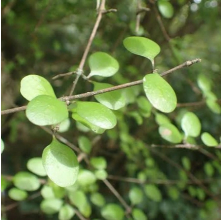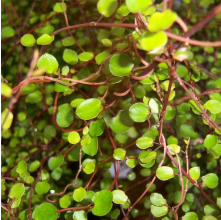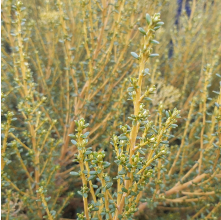Prices:
| |
Each |
20 or more |
| 2.5L Pot |
$9.50 |
$9.00 |
Details:
| Type: |
Shrub |
| Growth Rate: |
Medium |
| Mature Height: |
2 m |
| Mature Width: |
2 m |
| Site Condition: |
Coastal, Exposed, Frost Tolerant, Heavy Soil, Loamy Soil, Sandy Soil |
| Sun: |
Full Sun, Part Shade |
| Drainage: |
Dry, Moist |
| Frosts: |
Hardy |
| Features: |
Drought tolerant. Suitable for hedging or shelter. Attractive to birds, insects and lizards. Rongoa. Flower colour: White. Foliage colour: Bronze. Fruit colour: Black. Native. Suitable restoration species. |
Muehlenbeckia astonii, Pohuehue, is a coastal divaricating shrub with a wiry interlacing habit. Small, bright-green heart-shaped leaves. This plant is extremely hardy, tolerating dry conditions and wind. Popular landscaping plant, providing great contrast. Makes an attractive topiary or hedge. Attracts birds, insects and lizards. Semi-deciduous. Hardy.
Unlike most New Zealand plants M. astonii is leafless in winter. This is when the distinctive branches add interest to the garden. It grows from a distinct trunk and has many fine reddish-brown to orange flexible branches that zigzag around one another to form a dense, interwoven ball. Its flowers, appearing from December to January, are tiny and are greenish to white or pinkish white. The fruits are sweet and edible, eaten by birds and lizards. The plant is an important host for several endemic insect species and in some cases their sole host.
Habitat: Coastal to lowland. This species is associated with “grey” scrub communities, largely confined to drier lowland parts of eastern New Zealand. It is found on moderate to high fertility soils. Its deep root system helps it survive in dry conditions, and can grow on open rocky hillsides and stony ground. It prefers free-draining, warm, sunny slopes, such as the mid-dune areas along the coast. The plant is often found in association with Coprosma crassifolia, Coprosma propinqua, Muehlenbeckia complexa, Discaria toumatou, Olearia solandri and Ozothamnus leptophyllus.
Flowering: Spring - Summer [August - January]
Fruiting: Summer - Autumn [October - April]

